A strategic approach to sourcing is one way your legal department can enhance its legal operations to drive growth and achieve a competitive advantage for your company. In this article we outline three steps to developing a strategic approach to sourcing.
What is right-sourcing?
Right-sourcing is matching a legal departments various work needs with the optimal combination of sourcing options (out-sourcing, in-sourcing, tech-sourcing) in a way that delivers the most effective outcome. It is a method that legal teams can use to evaluate both the company’s expectations and the resources, capabilities and potential limitations of the legal department itself to make decisions that coordinate various elements of legal operations to achieve objectives.
A considered, strategic approach
Strategic sourcing has become an essential competency for General Counsels. The growing volume, complexity and risks associated with corporate and regulatory legal matters, coupled with restraints to the legal budget means in-house lawyers must devise and utilise more time and cost-effective sourcing models. To that affect, the in-house legal function must engage in right-sourcing to determine the most effective way to manage workloads, procure a service or complete a task to ensure they make the most efficient use of the available resources.
Strategic right-sourcing in 3 steps
This article will present 3 steps your legal department can take to formulate a right-sourcing strategy that can meet your company’s expectations and achieve the legal department’s objectives, while making the most efficient use of resources.

Right-sourcing strategy overview
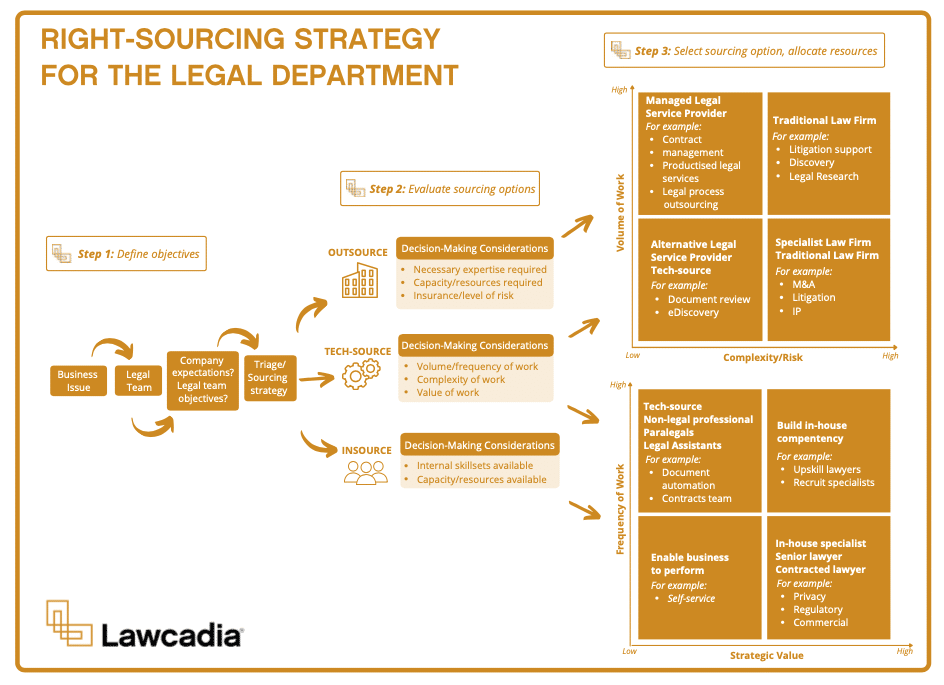
We will now examine each step independently and provide insights regarding how your legal department can formulate its right-sourcing strategy.
Step 1: Define objectives
The first step in formulating a right-sourcing strategy involves assessing the company’s expectations and then identifying and prioritising the objectives of the legal department based on those expectations.
Some objectives can include:
- Reducing costs
- Decreasing time for review and production (increasing efficiency)
- Increasing visibility and control of data
- Demonstrating value
- Managing risk
- Getting the right legal advice at the right time
Consequently, the legal team can devise a right-sourcing strategy that supports their objectives while meeting the company’s needs. A right-sourcing strategy can also allow the legal team to:
- Achieve a balance between financial and non-financial objectives
- Optimise the entire matter life cycle through effective legal project management (LPM)
- Increase agility and flexibility to easily adapt to the changing environmental and organisational needs
- Increase predictability and consistency by providing access to data-driven insights that can be used to make informed-decisions in future matters
- Enhance the role of the legal department
The first step is illustrated in figure 1, where the legal team receives a matter and then devises a sourcing strategy based on their company’s expectations and their objectives.
Figure 1: Right-sourcing strategy. Step 1: Define objectives
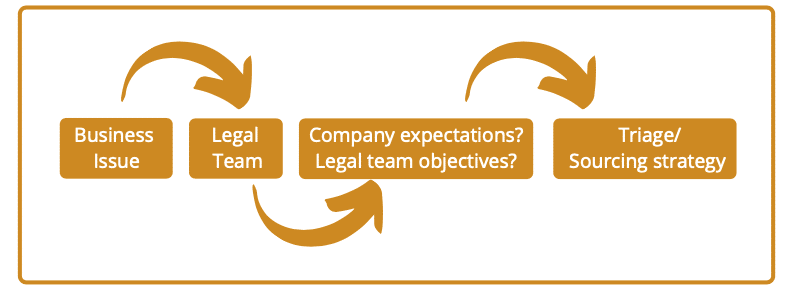
Step 2: Evaluate sourcing options
The second step in a right-sourcing strategy is to evaluate the range of sourcing options available to complete the work.
Traditionally, the main sourcing options for legal departments have been to delegate matters internally (in-source) or brief out to external law firms or other service providers (out-source). Recently, emerging legal technologies have presented an additional sourcing option, known as tech-sourcing, that can streamline workflows and accelerate task completion by reducing the volume of manual work. When used alongside processes such as legal intake and triage, tech-sourcing can significantly increase efficiency and productivity by automating low value and repetitive tasks.
Below are brief descriptions of each sourcing method:
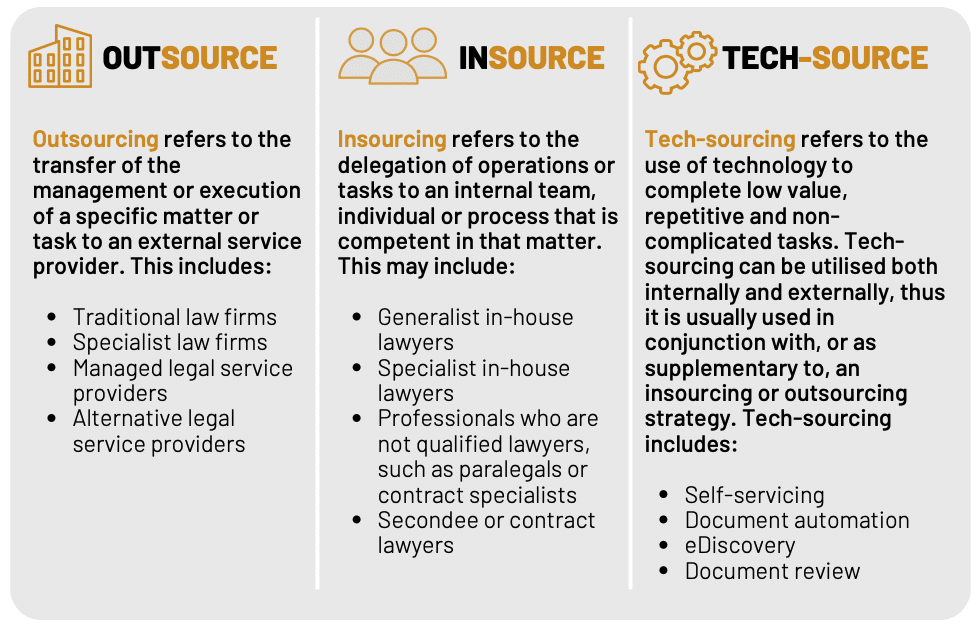
Although insourcing and outsourcing may continue to be the core categories of sourcing for the legal department, the decision-making process can, and should be, structured and strategic.
Accordingly, in addition to adapting the sourcing strategy to meet the company’s expectations and achieve the legal team’s objectives, the decision-making criteria should also be adapted depending upon the particular sourcing option in question as shown in figure 2 below.
Figure 2: Right-sourcing strategy. Step 2: Evaluate sourcing options
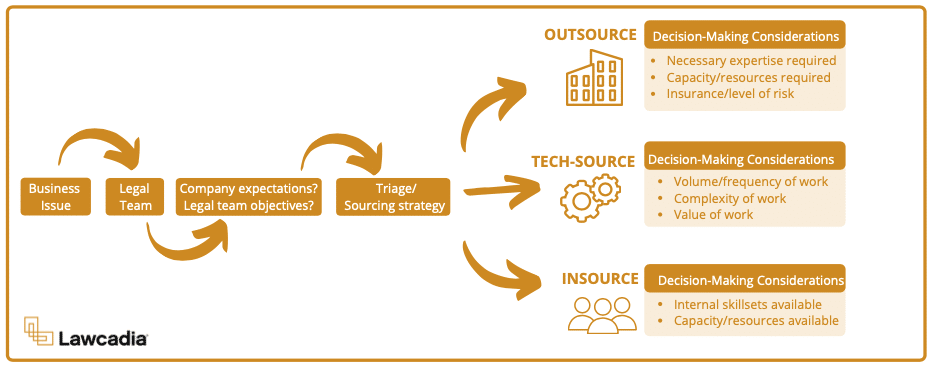
Step 3: Select sourcing option
The third step in a right-sourcing strategy involves selecting a sourcing option(s) and allocating resources. Depending on the sourcing option selected, there are several additional considerations the legal team must make to ensure that the resources are allocated in the most efficient way. These are discussed in further detail below.
Outsourcing
In the event that the legal team opts to outsource a legal matter, there is opportunity for the legal department to formulate the strategy such that there is a framework that expresses the conditions surrounding when work is briefed, to whom it is briefed and why it is briefed. This will ensure that matters are allocated through an informed and justified process through which the legal team can achieve their objectives and meet the company’s expectations.
When preparing a strategy for outsourcing, consider the following:
- The level of expertise required
- Capacity and resources available (people, time, and money)
- The perceived level of risk and insurance requirements
- The volume of work
This process is illustrated in figure 3 below in which tasks are allocated based on their complexity and volume, in relation to the level of expertise and capacity required to complete the task.
Figure 3: Right-sourcing strategy. Step 3: Strategically outsourcing legal matters
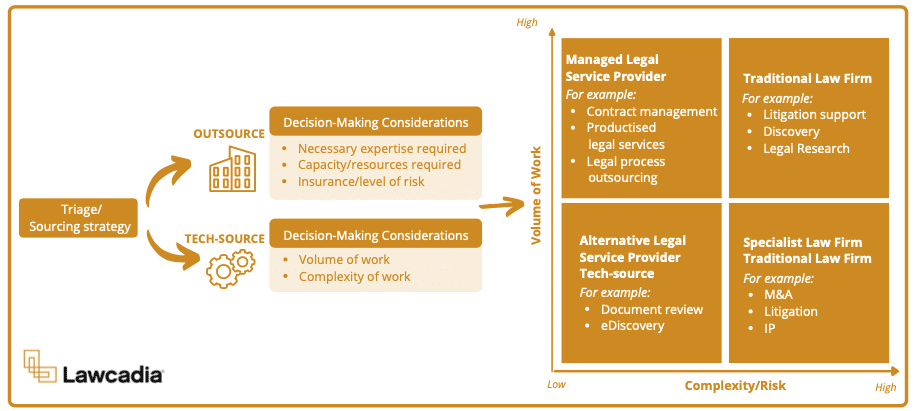
Insourcing
In the event that the legal team opts to insource a legal matter, having a formalised, structured approach and decision-making framework can assist in ensuring the right work is allocated to the right people in a manner that will meet the company’s expectations and achieve the legal team’s objectives, while fully optimising the available skills and resources.
The criteria for determining the work to be allocated internally can include:
- The internal skillsets available
- The capacity and resources available
- The frequency of the work
- The value or strategic impact of the work
This process is illustrated in figure 4 below, in which tasks have been allocated based on the frequency and strategic value of the work with consideration to the resources available and the internal skillsets of the team.
Figure 4: Right-sourcing strategy. Step 3: Strategically insourcing legal matters
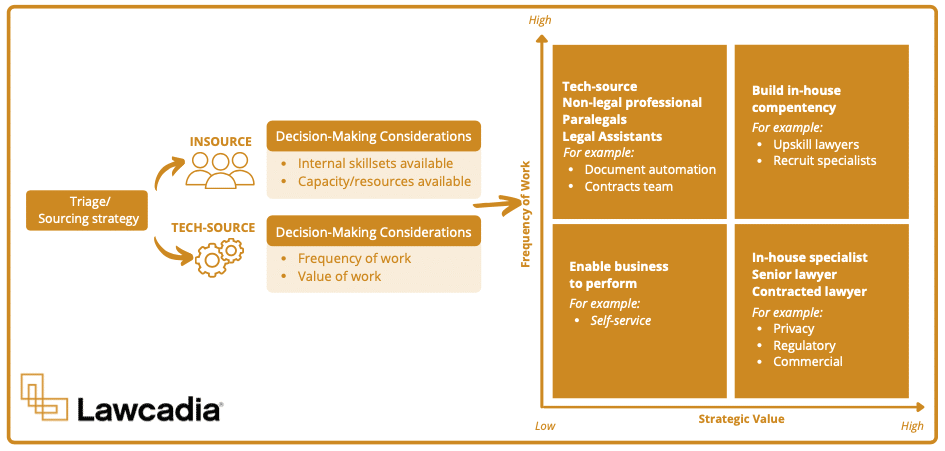
The role of technology
In either case of outsourcing or insourcing, incorporating legal technology into the strategy ensures a consistent approach that can also be customised for a specific task, client, or team. Moreover, access to data provides insights that can be used to predict and make future decisions to further optimise the resources available, contribute to the company’s strategic operations and elevate the role of the legal team. An example of this is to use workflow automation to replicate the triage of legal work based on predetermined rules and established workflows.
Additional benefits of integrating technology in the right-sourcing strategy include:
- Removing bias from the decision-making processes
- Digitising manual processes
- Capturing data for strategy evaluation and continuous improvement
Conclusion
Right-sourcing has become an essential competency in the ‘business of law’ for in-house legal teams. By identifying the company’s expectations, creating objectives and formulating a sourcing strategy, the in-house team can optimise legal operations to make the most efficient use of resources. Furthermore, incorporating technology into the strategy can ensure consistent and repeatable processes that provide valuable insights to make informed decisions to enhance future outcomes.

